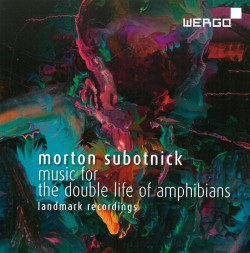 Morton Subotnick – Music for the Double Life of Amphibians (Landmark Recordings)
Morton Subotnick – Music for the Double Life of Amphibians (Landmark Recordings)
Various Artists
Wergo WER 7312 2
For most of his notable career American composer and electronic music pioneer Morton Subotnick (b. 1933) has employed his signature methodology of live electronically processed scored acoustic instrumental and/or vocal parts, and later, interactive computer music systems.
Subotnick has also been an important actor in many of the significant technological milestones in the commercialization of electroacoustic music. A prime example is his early Silver Apples of the Moon (Nonesuch LP 1967). Produced using the Electric Music Box, Don Buchla’s analogue modular voltage-controlled synthesizer and tape-manipulated sounds, it is considered the first electronic work commissioned by a record company. In it, the composer challenged academic avant-gardists by including sections with metric, regular rhythms. More significantly, he aimed to render a musical composition for which the performance was the recording, reflecting the spirit of Marshall McLuhan’s 1964 phrase “the medium is the message.” The album sold very well internationally and was highly influential: it was a touchstone of my own first experiments in tape and electronic music.
Recorded in a studio between 1981 and 1985 the music for Subotnick’s Music for the Double Life of Amphibians continued his fruitful commercial relationship with the Nonesuch label. This skillfully remastered current Wergo CD is part of a series dedicated to Subotnick’s recorded oeuvre. Each of the seven movements form part of a larger symphonic poem, and the resulting dramatically compelling music successfully treads over several genre lines. It seamlessly combines modernist chamber music – superbly performed by cellist Joel Krosnick in the outstanding Axolotl, as well as by the Juilliard Quartet and by the soprano Joan La Barbara – with (1980s) state-of-the-art studio electronics.
The album strongly affirms the composer’s modernist lineage. It also reminds us of his street cred in the development of 20th-century electroacoustic music’s creation, performance, studio recording and commercial release.



